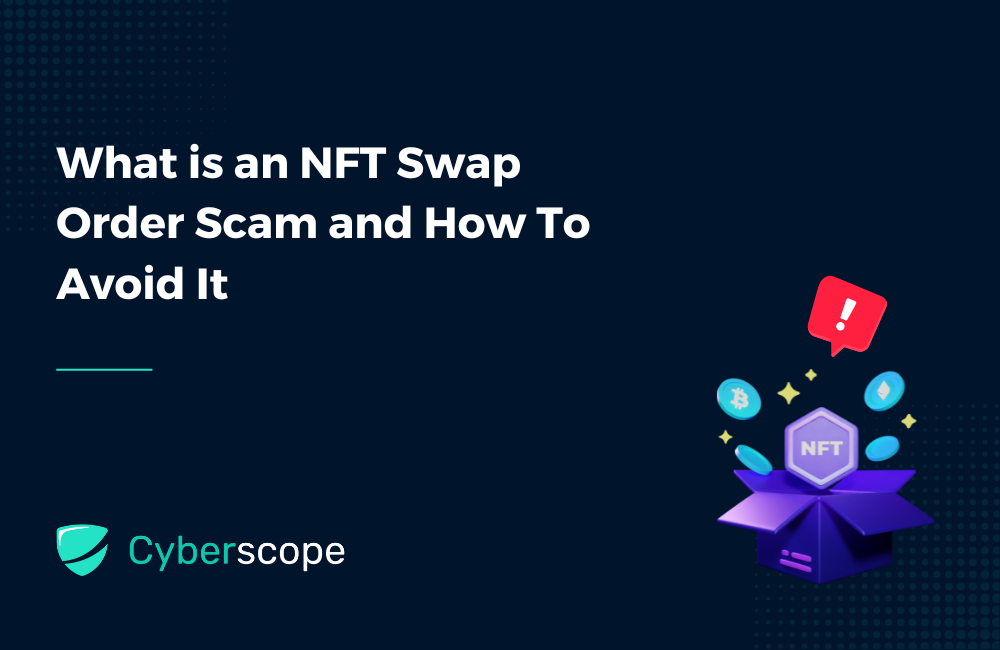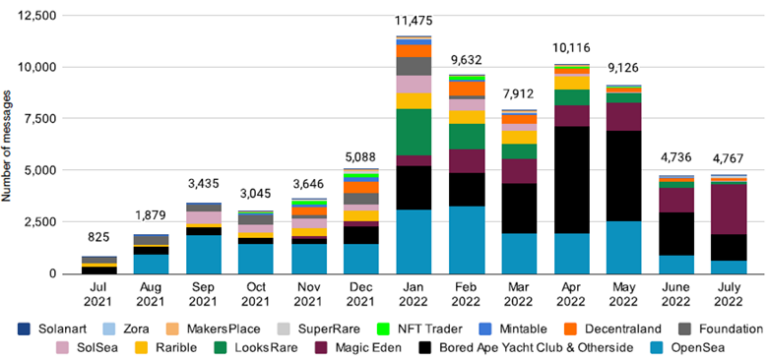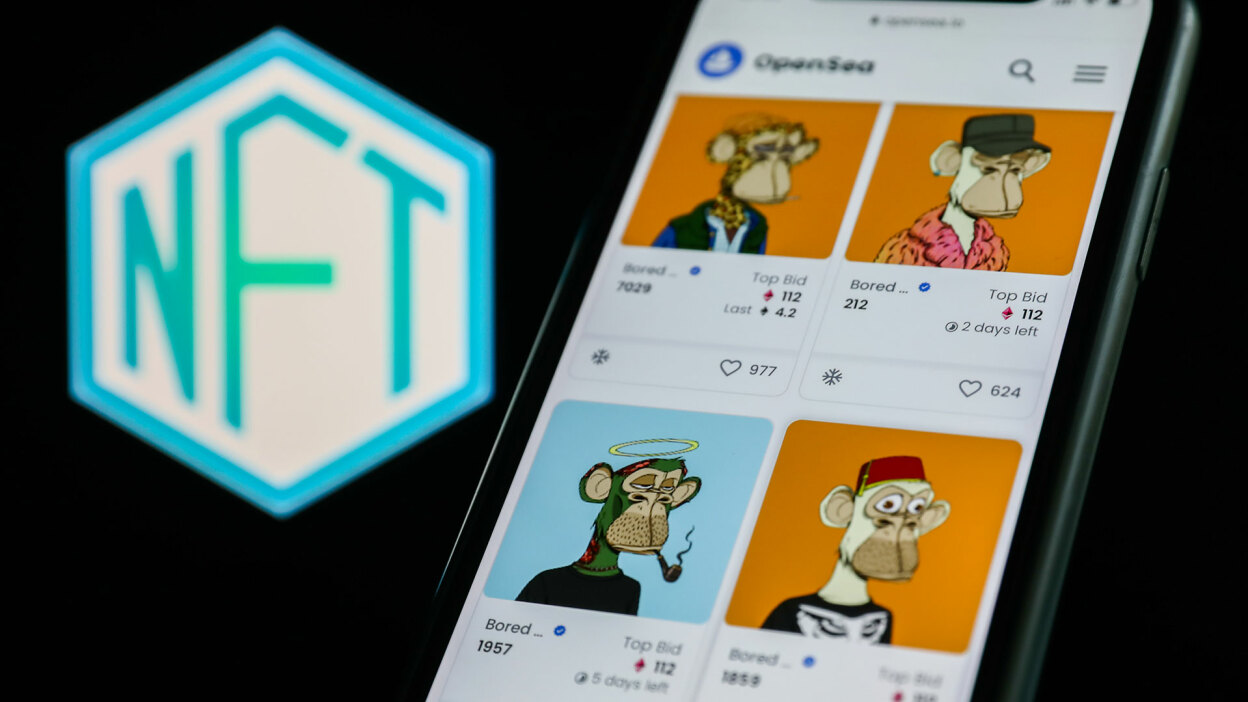.jpg%3Falt%3Dmedia&w=640&q=75)

What is an NFT Swap Order Scam and How To Avoid It

Ever wondered about the hidden dangers in the world of NFTs? Curious about the potential pitfalls that could be waiting for unsuspecting enthusiasts? Let's delve into an aspect that demands our attention: NFT Swap Order Scams.
For those unfamiliar with the term, NFTs, or Non-Fungible Tokens, are digital assets that establish ownership or verify the authenticity of specific items or content through blockchain technology.
Now, picture a marketplace similar to traditional ones but with a digital twist – where people buy and sell NFTs based on how special and valuable they are. Platforms like OpenSea serve as one of the bustling hubs where users can explore, buy, and sell these unique digital gems.
But as the excitement around NFTs continues to reach new heights, the market has also attracted its fair share of opportunities and risks. The rapid growth and popularity have also raised concerns about scams and fraudulent activities.

Aspiring investors and enthusiasts need to exercise caution, conduct thorough research, and stay vigilant to avoid falling victim to potential scams or misleading schemes.
Today, we’ll discuss one of the most common scams in the NFT marketplace – The NFT Swap Order Scam. I know you came here to read about it specifically, but it was essential to clarify what NFTs are and how they work. Now, we’ll only be talking about this cunning scam and how to avoid it, so stay tuned and read till the end.
Decoding the NFT Swap Order Scam
The latest addition to the crypto market is Peer-to-Peer (P2P) NFT trades, allowing users to conduct direct exchanges between wallets without relying on a central protocol. Notable platforms like NFTTrader and SudoSwap facilitate secure NFT swaps using a mechanism known as a “Swap Order.”
Now, what is this swap order? Read ahead.
What Is an NFT Swap Order?
A swap order serves as a personalized trade option that anyone can generate for the purpose of exchanging NFTs. By endorsing a swap order, you grant authorization for the specified instructions within it, allowing the transfer of a designated NFT from your wallet.
This approach facilitates direct NFT exchanges between users' wallets, offering the flexibility to trade for another NFT, cryptocurrency, or a combination of both. The specific terms and conditions of the trade are set by the individual creating the order.
Once the swap order is initiated, it gets its dedicated page, furnishing comprehensive information about the trade. This includes a visual representation of the tokens involved in the exchange, a link redirecting to the OpenSea page exhibiting the hosting smart contract for the token, and another link leading to the Etherescan page showcasing thorough details of that smart contract.
Now, let’s talk about how this can be used to scam people.
What is an NFT Swap Order Scam?
NFT swap order scams are schemes where an individual tricks someone into exchanging their valuable digital item for one of little or no value. The scam typically unfolds with the scammer fabricating a false contract, claiming it represents a high-value digital item and proposing a swap for a less valuable counterpart. The scammer vanishes once the victim sends their prized digital possession, leaving the victim empty-handed.
Scammers employ various tactics to carry out these schemes. One common strategy is to create a counterfeit contract that mimics the appearance of a trustworthy source, using logos or branding from well-known digital platforms. Despite attempts to appear legitimate, closer inspection reveals subtle differences, exposing the fraudulent nature of the contract.
Another approach involves scammers offering seemingly irresistible trades. For instance, they might suggest swapping a rare and valuable digital item for a common and inexpensive one. The allure of acquiring a valuable digital item at a seemingly low cost entices victims, who often realize the deception only after the transaction is complete.
Social engineering is also a tool scammers use, assuming false identities, such as pretending to be a well-known digital collector or influencer. By adopting a fake persona, scammers build a fabricated sense of trust and credibility with the victim, furthering their deceptive agenda.
Adding a layer of urgency to their tactics, scammers may insist that the trade needs to happen swiftly or claim that the digital item is in high demand and will soon be unavailable. By introducing urgency, scammers create pressure on the victim to make impulsive decisions, often without fully considering the potential risks involved in the transaction.

How does an NFT Swap Order Scam Happen
This is a very common and elaborate scam which now occurs more frequently. Someone new to the NFT world can become prey to this scam, so it is recommended that new traders be very vigilant about this kind of thing.
Let’s see how the whole thing works.
1. Bait and Switch
Scammers initiate the NFT swap order scam by creating fraudulent NFT listings or auctions on popular NFT marketplaces. These deceptive listings typically involve high-value, rare, or popular NFTs. Scammers employ enticing descriptions, attractive images, and promotional materials to lure potential victims, making fake NFTs appear exceptionally desirable and valuable.
2. False Offers
Now that the listing is created, scammers approach potential victims, often through social media platforms or direct messages. They claim to possess the sought-after NFT that the victim desires and propose a swap, suggesting that they are willing to exchange it for another NFT owned by the victim. This tactic preys on the victim's interest in obtaining a particular NFT.
3. Pressure Tactics
To create a sense of urgency and coerce the victim into making quick decisions, scammers employ high-pressure tactics. They may assert that the offer is time-sensitive or insinuate that there are other eager buyers for the NFT in question. This urgency is intended to manipulate the victim into hastily agreeing to the swap without thorough consideration.
4. Bogus Escrow Services
To add an illusion of legitimacy to the transaction, scammers propose using an escrow service. This service is purportedly designed to hold both NFTs involved in the swap until both parties are content with the exchange. However, the escrow service, in reality, is either fake or under the control of the scammer, providing a false sense of security to the victim.
5. Unfair Trades
Upon the victim's agreement to the swap, the scammer performs the deception by sending a counterfeit or significantly lower-value NFT instead of the promised high-value one. Victims often only realize they have been duped after the completion of the transaction, discovering that the received NFT does not match the expected value.
6. Disappear
Once the scam is successful, the scammer disappears, making it challenging for the victim to trace them or seek any form of recourse. This vanishing act further exacerbates the difficulties for victims in recovering their losses or taking legal action against the scammer.
Read About Another NFT Scam: What is Sleep Minting? Everything You Need to Know
Case Study: NFT Swap Order Scam of MAYC Token
In September 2022, a regular NFT trader encountered a new and deceptive scam within the Web3 space, resulting in the unfortunate loss of a prized MAYC (Mutant Ape Yacht Club) during an NFT swap.
The scammer directly contacted the victim through a private message, proposing a seemingly straightforward swap of two MAYC tokens, with the scammer sweetening the deal by offering additional ETH. The scammer created a swap order to facilitate the exchange and shared the code with the victim. The swap page clearly represented the scammer's assets on the left and the victim's assets on the right.
Despite the seemingly transparent swap page, crucial details were concealed. Notably, the page failed to confirm the authenticity of the incoming NFT regarding its collection. True verification requires examining the underlying smart contract, as any image can be minted onto the blockchain. This can be achieved by clicking on the Etherscan embed within the page.
A closer look at the smart contract details on Etherscan would have exposed these red flags:
- Brand New Smart Contract: The fake NFT belonged to a smart contract created just a day before the swap, whereas the genuine MAYC collection was minted in August 2021.
- Spelling Error in Contract Name: The NFT contract name contained a spelling error, indicating that it was not an authentic MAYC token.
Failure to cross-check the token using Etherscan led the trader to miss critical opportunities to identify the scam, resulting in the accidental exchange of their valuable MAYC for a fraction of its actual worth. The inclusion of valid ETH in the deal, thanks to the SudoSwap protocol, added an additional layer of deception to the scam.
Other Case Studies
Let’s talk about a few more instances where this scam happened and caused a stir in the NFT market.
Max Osiris
In March 2021, Max Osiris, an NFT collector, fell prey to an NFT swap order scam. Despite initial suspicions, Osiris traded his valuable NFT with an individual posing as a reputable collector. Regrettably, the promised trade never materialized, and the scammer vanished with Osiris's NFT.
Nifty Gateway
In February 2021, Nifty Gateway, a popular NFT trading platform, faced a series of swap order scams. Scammers created fake listings, enticing victims with valuable NFTs in exchange for less valuable ones. Once the victims sent their NFTs, the scammers disappeared, leaving them empty-handed.
CryptoPunk NFT Scam
In January 2021, scammers devised a fake NFT contract for a rare CryptoPunk NFT, proposing to swap it for a less valuable counterpart. Despite the fake contract being exposed upon closer inspection, some users fell victim to the scam, resulting in significant losses.
OpenSea
In August 2020, the prominent NFT marketplace OpenSea experienced an NFT swap order scam. Scammers crafted deceptive listings for valuable NFTs, luring victims into trading for less valuable ones. After the victims sent their NFTs, the scammers disappeared, leaving them with nothing.
Rarible
In July 2020, an NFT trading platform, a Rarible user, encountered an NFT swap order scam. Despite initial suspicions, the user traded his valuable NFT with an individual claiming to be a well-known collector. Unfortunately, the promised trade never materialized, and the scammer absconded with the user's NFT.
Tips to Avoid NFT Swap Order Scams
In the Web3 space, where scams can pop up, there's reassuring news – everything is on-chain. This means you have more control and can peek behind the scenes to understand precisely what you're about to buy.
To spot scams, use these straightforward methods on your own and navigate the Web3 world with confidence.
1. Trade with Reputable and Verified Individuals or Platforms
Before engaging in any NFT trade, ensure the legitimacy of the individual or platform involved. Research their background, read reviews, and check their social media presence. Stick to established and reputable NFT platforms known for secure and reliable services.
2. Double-Check Wallet Addresses
Scammers often use fake wallet addresses to deceive victims. Always double-check the wallet address before sending NFTs or cryptocurrency. Look for spelling errors or inconsistencies, and confirm that the address belongs to the intended recipient.
3. Never Share Private Keys or Seed Phrases
Private keys and seed phrases are crucial for securing your NFT and cryptocurrency holdings. Never share this information with anyone, as scammers can exploit it to steal your assets. Keep private keys and seed phrases safe, and only enter them into legitimate and verified platforms.
4. Conduct Your Own Research and Due Diligence
Prior to any NFT trade, conduct thorough research. Verify the authenticity of contracts or listings and check the market value of the NFT to ensure fair trades. Be cautious of deals that appear too good to be true, as scammers often use this tactic to lure unsuspecting victims.
5. Trust Your Instincts and Avoid Rushed Trades
If a trade seems too good to be true, it likely is. Trust your instincts and avoid rushing into any trade without careful consideration. Take the time to research, verify, and assess the risks associated with the trade before sending NFTs or cryptocurrency.
Quick Link: What is Address Poisoning in Crypto?
Key Takeaways
In the world of Web3, where your wallet is like a key to a new internet, it's super important to keep your cryptocurrency safe. There's no way to undo mistakes in this kind of internet, so you need to be really careful. Lately, there's been a rise in NFT swap order scams when people are trading NFTs. This means it's extra important for traders to know about these scams and how to avoid them.
To stay safe from NFT swap order scams, stick with well-known platforms and people, check your wallet addresses carefully, don't share your private info, and always research before trading NFTs. Even though NFTs can be cool, you must be aware of what's happening. Knowing who you can trust and who might not be honest is really important. So, always be careful and learn as much as possible before jumping into the world of NFTs.
Recent Posts
.jpg%3Falt%3Dmedia&w=640&q=75)


What is a Fallback Attack in Smart Contracts?
5 months ago
